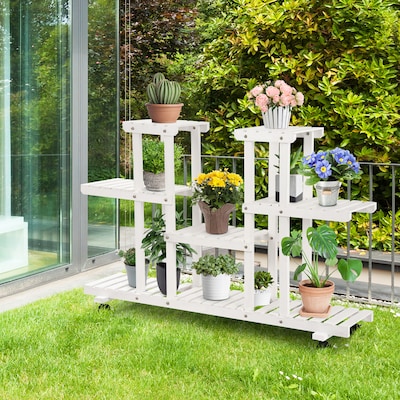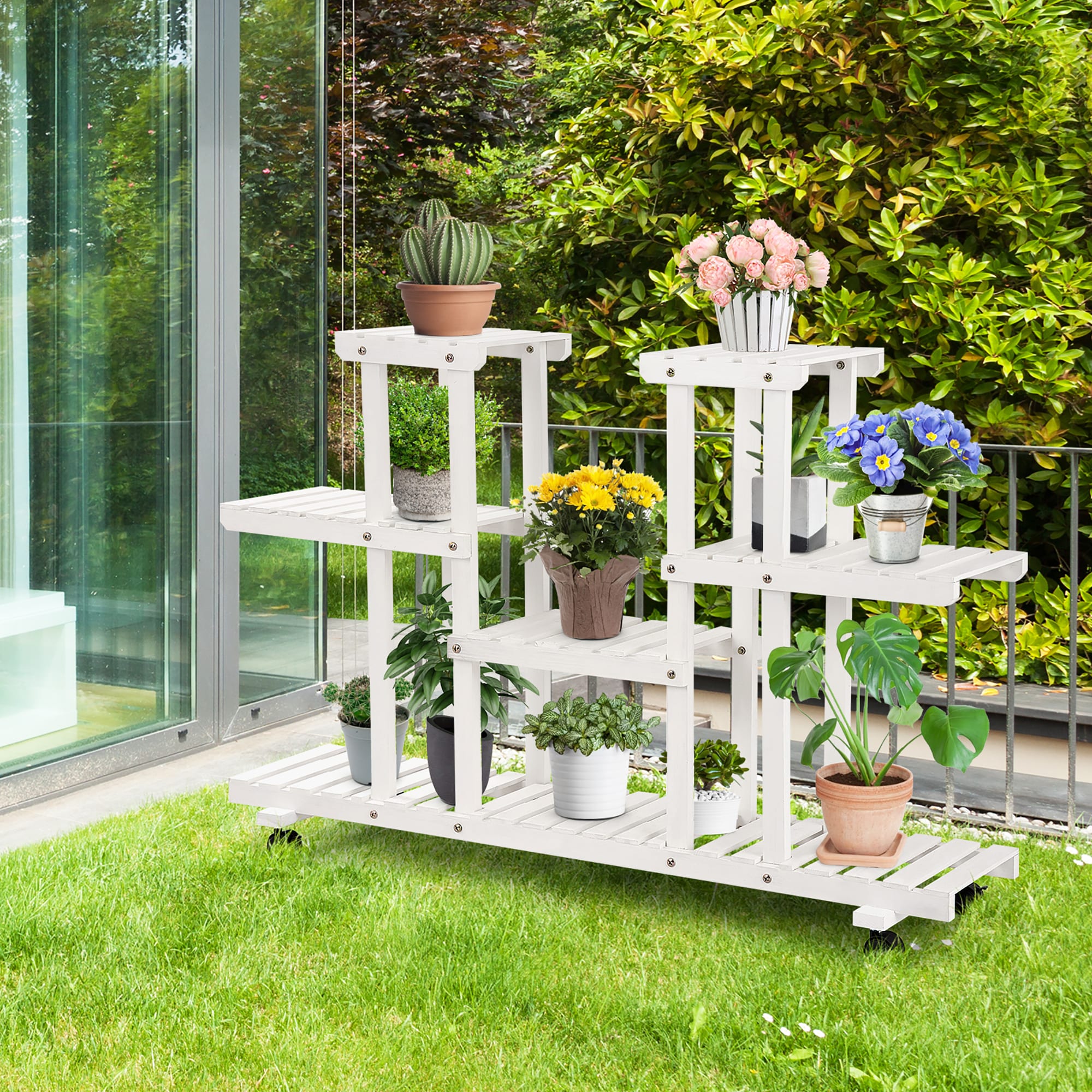Plant stands outdoor enhance the display of your potted plants. They elevate greenery, optimizing space and sunlight.
Outdoor plant stands come in a variety of materials, including metal, wood, and plastic, each offering durability and style to suit different garden themes. These stands are not only functional, providing better air circulation for plant health, but they also add aesthetic value to any outdoor space.
Whether you have a sprawling backyard or a small balcony, incorporating a plant stand can transform your area into a lush and organized oasis. They are available in multiple tiers, sizes, and designs, allowing gardeners to create a customized look while showcasing their plant collection. Perfect for patios, decks, and balconies, outdoor plant stands are essential for any plant enthusiast looking to elevate their garden’s appeal.

Credit: www.lowes.com
Introduction To Outdoor Plant Stands
Outdoor plant stands breathe new life into your garden. They create eye-catching levels for your plants. This maximizes your space and showcases the beauty of your greenery. Plant stands outdoors are more than functional; they are pieces of art that enhance any garden, patio, or balcony.
Benefits Of Using Plant Stands
- Elevates plants for better sunlight exposure
- Improves air circulation around plants
- Prevents pests from easily reaching plants
- Creates visual interest with varied levels
- Allows for more plants in a small space
- Keeps plants off the ground, reducing water damage
Types Of Plant Stands Suitable For Outdoors
| Type | Material | Best For |
|---|---|---|
| Multi-tiered | Wood, Metal | Displaying multiple plants |
| Corner | Wrought Iron, Rattan | Maximizing small spaces |
| Hanging | Macramé, Steel | Suspension from ceilings or walls |
| Pedestal | Stone, Ceramic | Featuring a single showpiece plant |
Material Choices For Durability
Choosing the right material for outdoor plant stands is crucial for both style and longevity. Different materials offer unique benefits and can withstand varying weather conditions. Let’s explore the options to ensure your greenery remains elevated and impressive year-round.
Wooden Plant Stands: Pros And Cons
Wooden plant stands add a warm, natural touch to any outdoor space. They blend seamlessly with the environment and can be very sturdy.
- Pros:
- Natural aesthetic
- Sturdy and heavy-duty
- Can be painted or stained
- Cons:
- May require regular maintenance
- Can rot or warp with moisture
- Prone to insect damage
Metal Plant Stands: When To Choose Them
Metal plant stands are a fantastic choice for durability and style. They resist weather well and come in various designs.
| Advantages | Considerations |
|---|---|
| Long-lasting and rust-resistant | Can get hot in direct sunlight |
| Versatile designs | May be heavier to move |
| Low maintenance | Can dent or scratch |
Plastic And Other Materials: Lightweight Options
Plastic plant stands offer a lightweight and versatile solution. They work well for those who often rearrange their outdoor spaces.
- Resistant to moisture and decay
- Easy to clean and move
- Available in numerous colors and styles
Other materials such as fiberglass or resin also provide unique textures and durability, though they may vary in quality and price.
Design Styles For Outdoor Plant Stands
Outdoor plant stands transform gardens into living art displays. They come in many styles. Each style adds a unique charm to your outdoor space. Let’s explore the design styles for these garden beauties.
Traditional Designs
Traditional outdoor plant stands bring timeless elegance. They often feature wrought iron or wood. These stands usually have classic lines and curves. Scrollwork and decorative patterns are common. They fit well in classic garden settings.
- Wrought iron stands with vintage motifs
- Wooden stands with lattice work
- Multi-tiered structures for grand displays
Modern Touches
For those who prefer a contemporary look, modern plant stands are perfect. They feature clean lines and minimalist design. Materials like metal and glass are popular. These stands often come in bold colors or metallic finishes.
- Geometric shapes for a sleek appearance
- Modular designs that fit any space
- Stands with integrated lighting for night-time ambience
Customizable Features
Customizable plant stands are great for personal expression. They can be tailored to your space and taste. Adjust the height, number of shelves, or color. Some even offer detachable parts or expandable frames.
- Adjustable stands for various plant sizes
- Options to mix and match parts
- Stands that grow with your garden

Credit: www.lowes.com
Choosing The Right Size And Shape
Imagine your outdoor space transformed into a botanical paradise. The key? Selecting the perfect plant stand. Size and shape matter to create harmony in your garden. Let’s explore how to pick plant stands that fit your space like a glove.
Considerations For Small Spaces
Maximize your area with the right plant stand. Small spaces need smart solutions.
- Choose compact designs that don’t overwhelm your patio or balcony.
- Opt for multi-tiered stands to display more plants in less space.
- Corner stands tuck into tight spots, making use of every inch.
- Look for folding options to change up the scene or store when not in use.
Best Choices For Large Gardens
In sprawling gardens, plant stands should make a statement. Think big and bold.
- Wrought iron stands provide sturdy elegance and withstand the elements.
- Large wooden ladders showcase a rustic charm and host multiple plants.
- Heavy-duty stands are ideal for large pots and heavy flora.
- Wide bases ensure stability on uneven garden terrain.
Layering Plants Vertically
Vertical gardening is a trend that saves space and looks stunning.
- Stack plant stands for a cascade of greenery.
- Select tiered stands for a natural waterfall of flowers.
- Use hanging planters to add another dimension to your garden tapestry.
- Combine stands of different heights for a dynamic display.
Setting Up Your Plant Stand
Ready to showcase your green beauties in the great outdoors? A plant stand can elevate your garden’s appeal, literally. Let’s set up your outdoor plant stand with ease and ensure it’s ready to weather any storm.
Step-by-step Installation
- Choose the right location: Pick a spot that gets the right amount of sunlight for your plants.
- Unpack and sort: Open the package and lay out all pieces. Check the manual for a parts list.
- Follow instructions: Use the manual to assemble. Start from the base, working your way up.
- Tighten all connections: Ensure screws are snug to prevent wobbling.
- Place your plants: Arrange them by size or type for a stunning display.
Maintaining Stability In Various Weather Conditions
- Choose sturdy materials: Metals or treated woods withstand the elements best.
- Weight the base: Add rocks or sandbags at the bottom for extra support.
- Secure to the ground: Use stakes or anchors for stands that have this option.
- Adjust for wind: Turn pots to reduce wind resistance and prevent tipping.
- Regular checks: Inspect your stand post-storm to tighten and correct any tilts.
Safety Tips
- Keep walkways clear: Ensure the stand doesn’t block paths to avoid trips.
- Stable on flat ground: Set your stand on even terrain to prevent accidents.
- Child and pet proof: Avoid sharp edges and toxic plant choices.
- Regular maintenance: Tighten loose parts and replace any rusted elements.
- Weather awareness: Move or cover your stand during extreme conditions.
Optimal Plant Types For Outdoor Stands
Outdoor plant stands transform patios and balconies into lush gardens. Choosing the right plants is crucial. These plants thrive outdoors and bring life to any stand.
Flowering Plants
Colorful blooms create a visual feast on outdoor stands. Consider these flowering plants:
- Geraniums: Hardy and vibrant.
- Marigolds: Easy to grow and pest-resistant.
- Petunias: Offer a variety of colors.
Sunlight and regular watering keep them blooming.
Succulents And Cacti
Drought-tolerant and low-maintenance, these plants suit busy gardeners.
| Succulent | Feature |
|---|---|
| Aloe Vera | Healing properties |
| Echeveria | Rosette shapes |
| Sempervivum | Thrives in cold |
Well-draining soil is a must for these plants.
Foliage Plants
Foliage plants bring texture and greenery to stands.
- Ferns: Love shade and moisture.
- Hostas: Thrive in partial sun.
- Palms: Add tropical flair.
Ensure adequate space for growth.
Accessorizing Your Plant Stands
Make your outdoor spaces shine by dressing up your plant stands. Simple accessories can transform your garden into a magical place. Here’s how to do it:
Using Planters And Pots
Choosing the right planters and pots is key. Here are some tips:
- Match styles and colors to create a theme.
- Use different sizes for depth and interest.
- Ceramic pots add a touch of elegance.
Decorative Elements
Add fun touches to catch the eye:
- Colorful stones or pebbles fill empty spaces.
- Small figurines or statues make it lively.
- Hang wind chimes for sweet sounds.
Lighting For Nighttime Display
Light up your garden at night:
- Wrap string lights around larger plants.
- Use solar lights for an eco-friendly choice.
- Spotlights can highlight a special plant.
Accessorizing your plant stands is easy and fun. It makes your garden beautiful day and night. Try these ideas and enjoy your lovely space!

Credit: www.amazon.com
Maintenance And Care Tips
Maintaining your outdoor plant stands is essential. Proper care keeps them looking great and lasting longer. Follow these simple tips to ensure your plant stands withstand the elements and continue to beautify your outdoor space.
Routine Cleaning
Regular cleaning is key to maintaining your plant stands. Dirt and debris can cause wear and tear over time. Here’s how to keep them clean:
- Wipe down weekly with a damp cloth.
- Use a mild soap solution for monthly deep cleans.
- Rinse with clean water to remove any soap residue.
Protecting From Weather Damage
Outdoor elements can damage your plant stands. Protect them with these steps:
- Apply a waterproof sealant annually to guard against rain and snow.
- Move stands to shaded areas during extreme sun exposure.
- Cover them during severe weather conditions, if possible.
Seasonal Adjustments
Changing seasons require different care strategies for your plant stands:
| Season | Care Tips |
|---|---|
| Spring | Check for any winter damage and repair. |
| Summer | Ensure stands are not in direct sunlight. |
| Fall | Prepare stands for colder weather with a fresh sealant. |
| Winter | Store indoors or cover them if left outside. |
Adjusting care with the seasons will keep your stands in top shape year-round.
Inspirational Ideas
Imagine stepping into your garden and being greeted by a stunning display of greenery perched on stylish plant stands. Plant stands outdoor transform patios, balconies, and gardens into living art. Let’s explore ideas that will inspire your next outdoor plant sanctuary.
Real-life Examples
From urban balconies to suburban backyards, real-life examples of plant stands outdoor show their versatility. See how a simple wooden tiered stand brings a cozy feel to a corner. Notice the elegance of a wrought-iron stand overflowing with vibrant flowers. Each example illustrates the stands’ ability to enhance any space.
Gallery Of Styles
Dive into a visual feast with a gallery showcasing plant stand styles:
- Modern minimalism: Sleek lines and neutral colors
- Rustic charm: Natural wood and distressed finishes
- Victorian flair: Ornate metalwork and classic designs
- Bohemian vibes: Eclectic patterns and vibrant colors
Each style offers a unique way to display your plants and decorate your outdoor space.
Tips From Gardening Experts
Seasoned gardeners share their wisdom for choosing and using plant stands:
- Assess your space: Measure before you buy.
- Consider the elements: Choose materials that withstand weather.
- Think about growth: Select stands that accommodate growing plants.
- Balance is key: Distribute weight to prevent tipping.
These tips ensure your plant stands remain beautiful and functional year-round.
Frequently Asked Questions
What Can I Use Instead Of A Plant Stand?
You can use shelves, tables, hanging baskets, or repurposed furniture as alternatives to a plant stand. Consider using stacked books or cinder blocks for a creative twist.
What Is The Best Material For An Outdoor Plant Stand?
The best material for an outdoor plant stand is weather-resistant options like cedar, teak, metal with a powder coat, or UV-resistant plastic. These materials withstand the elements and maintain durability.
How Do I Display Potted Plants In My Backyard?
Choose varying heights and colors for visual interest. Group plants together for a lush look. Use shelves or plant stands to maximize space. Ensure pots have proper drainage to maintain plant health. Display in areas with appropriate sunlight for the plants’ needs.
How Do I Make A Homemade Plant Stand?
Choose sturdy materials like wood or metal. Measure and cut to desired dimensions. Assemble the base, legs, and shelves with screws or nails. Sand rough edges for safety. Finish with paint or varnish for protection and style.
Conclusion
Embracing the beauty of nature has never been easier with the right plant stand. Elevate your outdoor space and showcase your greenery with style and ease. Remember, the perfect stand not only complements your plants but also withstands the elements.
Transform your patio or garden into a serene retreat; let your foliage flourish on a stand that speaks to your aesthetic. Explore your options and find the ideal match for your botanical buddies.
